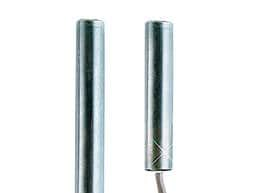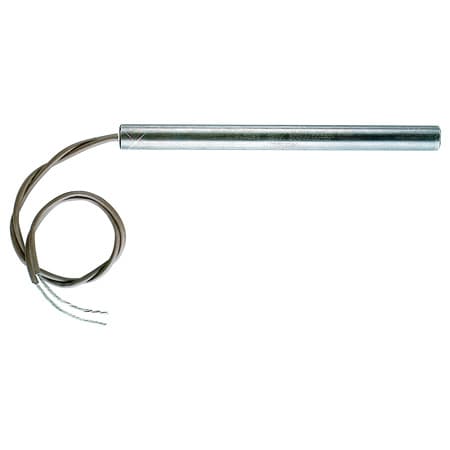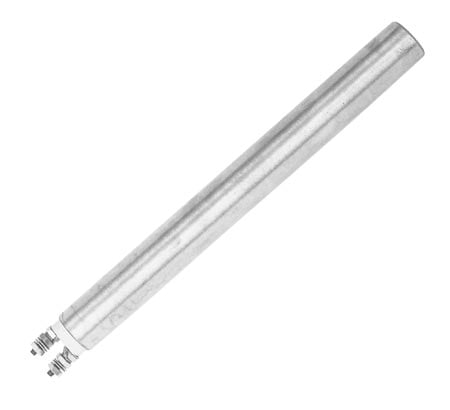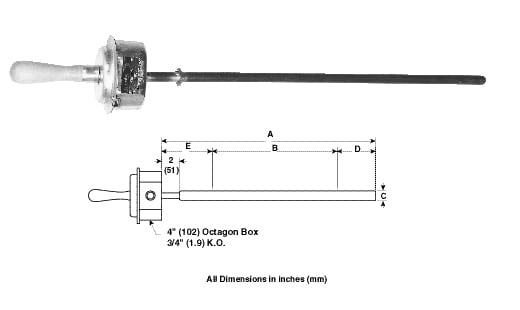A cartridge heater is a tube-shaped, industrial heating element that can be inserted into drilled holes. Cartridge heaters provide localized and precise heating and are commonly used in the heating process industry. Typically, cartridge heaters are used to heat a metal block from the inside and can be custom manufactured to a specific watt density based on the requirements of the application.
Cartridge heaters are most frequently used for heating metal parts by insertion into drilled holes. For easy installation, the heaters are made slightly undersize relative to their nominal diameter.
How does a Cartridge Heater work?
A cartridge heater consists of resistance coil wound around a ceramic core that is surround by dielectric and encased in a metal sheath. Powered heat transferred through the coil to the sheath causes the sheath to heat up. This heat is then transferred to the inside metal part requiring heat.
To fit a cartridge heater in a low or medium temperature application (600°F or less), general purpose drills are usually adequate for drilling holes. Holes can be drilled .003” to .008” over the nominal size of the drill, resulting in fits of .009” to .014.” While this fit is slightly looser than would permit optimal heat transfer, it aids in the installation and removal of the cartridge heaters, especially those with long sheaths. At high watt densities, a close fit is much more important. The holes should be drilled and reamed rather than just drilled with a general purpose bit. With a tighter fit, the heater will run cooler and have a longer life expectancy.
What are the operating temperatures of a Cartridge Heater?
Cartridge heaters can operate at low, medium, and high watt densities. They are designed to withstand a working temperature of up to 1400°F. However, the optimal operating temperature will depend on the application for which you are using the cartridge heater.
It’s also important to note that there are multiple factors, such as the cartridge heater watt density, the tightness of the cartridge inside the hole, and the thermal conductivity of the material being heated, that can impact the actual temperature of an industrial heater and the monitored temperature of a material during the heating cycle. For high temperature applications, such as those above 1000°F, incoloy sheathes are recommended for maximum heat transfer and durability.
It is also important to consider the electrical termination of a cartridge in regard to the operating temperature. When cartridge heaters are used at relatively high temperatures, the electric terminals should either be different than the common high temperature lead wires or the cartridge should be designed in a manner that the temperature around the lead wires is maintained at a lower temperature than the temperature limit of the lead wire.
What are Cartridge Heaters used for?
Cartridge heaters are most frequently used for heating dies, platens, molds, and other metal parts by insertion into drilled holes. They can also be used in liquid immersion applications. Below are some examples of specific applications:
- Heating gases and liquids
- Hot runner molds
- Hot stamping
- Laminating presses
- Medical equipment
- Semi-conductor
- Plastic molding
- Scientific equipment
Temperature Controllers and Sensors for Cartridge Heaters
The sensor for the temperature control is also an important factor and should be placed between the working surface of the part and the heaters. The temperature of the part approximately 1/2" away from the heaters is used in selecting maximum allowable Watt density from the graph. Control of power is an important consideration in high Watt density applications. On-off control is frequently utilized, but it can cause wide excursions in the temperature of the heater and working parts.
Thyristor power controls are valuable in extending the life of high Watt density heaters, since they effectively eliminate on-off cycling. There are a variety of temperature controllers and sensors one can use depending on the application. One of the more popular sensor types for cartride heater applications are the surface mount temperature sensors. Thermocouple, RTD or Thermistors are available with an adhesive backing or the ability to be cemented to the surface being heated.
There also bolt on and magnetic surface mount type temperature sensors available. Digital temperature controllers come in many different sizes with many output and input choices. Thermcouple and RTD inputs are the most popular with a dc pulse output. DC pulse ouputs allow the user to go to a larger relay to switch the heater load and use proportional control versus on/off control which can shorten the heater life.

Choose the right heater

1/4" Diameter Cartridge Heaters
OMEGALUX™ CIR series high watt density cartridge heaters are manufactured to the highest industry standards using only premium materials. They have been designed to last longer and outperform any other brand cartridge heater in both laboratory and industrial applications. Their heavy duty construction provides high dielectric strength as well as shock and vibration resistance.

1/2" Diameter Cartridge Heaters
OMEGALUX™ CIR series high watt density cartridge heaters are especially well suited for use in applications involving molds, dies, platens, hot plates, and sealing operations.

3/8" Diameter Cartridge Heaters
OMEGALUX™ CIR series high watt density cartridge heaters are especially well suited for use in applications involving molds, dies, platens, hot plates, and sealing operations. They are available in lengths from 1 to 24"..

3/4" Diameter Cartridge Heaters
OMEGALUX™ CIR series high Watt density cartridge heaters are especially well suited for use in applications involving molds, dies, platens, hot plates, and sealing operations. They are available in lengths from 2 1/4" to 48".

Heavy Duty Cartridge Heaters
OMEGALUX™ C Series heavy duty cartridge heaters are especially suited for use in applications involving hot plates, molds, dies, platens and container heating.

Electric Stud Heaters
CBH Series heaters are constructed of rugged metal sheathed tubular elements homogeneously combined with a metal sleeve that has been accurately dimensioned to provide a proper clearance and ease of inserting into standard drill hole sizes so large bolts or studs may be rapidly expanded and tightened with a wrench, providing ''shrink fit tightness" when cool. Useful in assembly of large compressors, presses, turbines, die blocks, cylinders, engine heads, pressure vessels, etc. Quick heat-up is important to avoid heat drain-away of surrounding metal. CBH heaters are generally used in sets to permit uniform tightening of mating parts.
FAQs
Determining Watt Density
The term "Watt density" refers to the heat flow rate or surface loading. It is the number of Watts per square inch of heated surface area. For calcualation purposes, stock cartridge heaters have a 1/4" unheated length at each end. Thus, for a 1/2" x 12" heater rated 1000 Watts, the Watt density calculation would be as follows:
Watt Density = W / (Π x D x HL)
Where:
W= wattage = 1000 W
Π = pi (3.14)
D= diameter = 0.5 inch
HL = Heated Length = 11.5 inch
Watt Density = 1000/(3.14 x .5 x 11.5) = 55 W/in
The majority of applications do not require maximum watt/in². Use a watt density only as high as needed. Take advantage of the safety margin provided by using ratings less than the maximum allowed. Select space heaters for most even heat pattern rather than the highest possible wattage per heater.
At medium Watt densities, general purpose drills are usually adequate for drilling holes. Typically, these result in holes .003" to .008" over the nominal size of the drill, resulting in fits of .010" .015". Of course, the tightest fit is desirable from a heat transfer standpoint, but somewhat looser fits aid in installing and removing cartridge heaters, especially long ones. Holes drilled completely through the part are recommended to facilitate removal of the heater. After drilling, clean or degrease the part to remove cutting lubricants.
At high Watt densities holes should be drilled and reamed, rather than just drilled to final diameter with a general purpose drill. At high watt densities, a close fit is important. The fit is the difference between the minimum diameter of the heater and maximum diameter of the hole. For example, at 1/2" diameter an OMEGALUX cartridge heater is actually .498" plus 000" minus .005". If this heater is placed in a hole which has been drilled and reamed to a diameter of .503" - .493" = .010").

